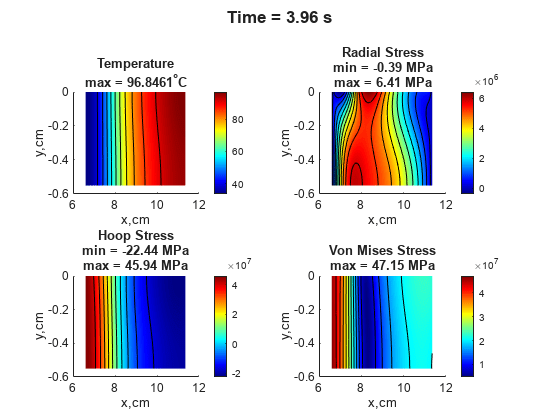Structural Mechanics
With structural analysis, you can predict how components behave under loading, vibration, and other physical effects. This helps you design robust mechanical components by validating designs through simulation and reducing the need for physical testing. For details about linear elasticity equations for plane stress, plane strain, and 3-D problems, see Linear Elasticity Equations.
You can perform linear static analysis, transient analysis, modal analysis, and frequency response analysis. The solver returns one of the results objects containing the basic solution values, such as displacement and velocity, at mesh nodes. After solving the problem, you can interpolate returned results to arbitrary spatial locations instead of mesh nodes and also evaluate other solution values, such as stresses, strains, and reaction forces.
Functions
filterByIndex | Access transient results for specified time steps (Since R2023b) |
evaluateStress | Evaluate stress for dynamic structural analysis problem |
evaluateStrain | Evaluate strain for dynamic structural analysis problem |
evaluateVonMisesStress | Evaluate von Mises stress for dynamic structural analysis problem |
evaluateReaction | Evaluate reaction forces on boundary |
evaluatePrincipalStress | Evaluate principal stress at nodal locations |
evaluatePrincipalStrain | Evaluate principal strain at nodal locations |
interpolateDisplacement | Interpolate displacement at arbitrary spatial locations |
interpolateVelocity | Interpolate velocity at arbitrary spatial locations for all time or frequency steps for dynamic structural problem |
interpolateAcceleration | Interpolate acceleration at arbitrary spatial locations for all time or frequency steps for dynamic structural problem |
interpolateStress | Interpolate stress at arbitrary spatial locations |
interpolateStrain | Interpolate strain at arbitrary spatial locations |
interpolateVonMisesStress | Interpolate von Mises stress at arbitrary spatial locations |
Objects
StaticStructuralResults | Static structural solution and derived quantities |
TransientStructuralResults | Transient structural solution and derived quantities |
ModalStructuralResults | Modal structural solution |
FrequencyStructuralResults | Frequency response structural solution and derived quantities |
Topics
- Deflection Analysis of Bracket
Analyze a bracket under an applied load and determine the maximal deflection by using the unified workflow.
- Structural Dynamics of Tuning Fork
Perform modal and transient analysis of a tuning fork.
- Stress Concentration in Plate with Circular Hole
Perform a 2-D plane-stress elasticity analysis.
- Dynamics of Damped Cantilever Beam
Include damping in the transient analysis of a simple cantilever beam.
- Modal Superposition Method for Structural Dynamics Problem
Use modal analysis results to compute the transient response of a thin 3-D plate under a harmonic load at the center.
- Thermal Deflection of Bimetallic Beam
Solve a coupled thermo-elasticity problem.
- Vibration of Square Plate
Calculate the vibration modes and frequencies of a 3-D simply supported, square, elastic plate.
- Reduced-Order Modeling Technique for Beam with Point Load
Eliminate degrees of freedom that are not on the boundaries of interest by using the Craig-Bampton ROM technique.
- Modal and Frequency Response Analysis for Single Part of Kinova Gen3 Robotic Arm
Analyze shoulder link of Kinova® Gen3 Ultra lightweight robot arm for deformations under applied pressure.
- Reduced-Order Modeling Technique for System-Level Simulation of Aircraft Wing Spar
Run system-level simulations by using the Descriptor State-Space block to implement a reduced-order model of the I-beam in an aircraft wing spar.


